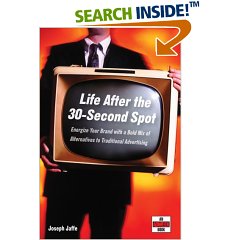Life after the 30-second spot: a review long overdue
I am a big fan of Joe. I regularly read his blog and I really enjoy his podcast, listening to it while driving to work (it is really motivational and inspires me a lot, which I enjoy in the morning!).
And I have (finally) read his book. I am very late writing about the book. Why am I writing about it nevertheless?
More than a year ago, Joseph Jaffe came up with a concept he called „UNMTPNM„: Use new marketing to prove new marketing. He launched this idea in order to promote his (then) new book:
Life after the 30-second spot
Energize your brand with a bold mix of alternatives to traditional advertising.

I decided to take part, as I liked the idea of how he wanted to start word-of-mouth this way. Now I want to write the review. It’s late, but I thought better late than never. And this way, Joe gets a new mention during a time, when everyone is already writing about his new book, which should be coming out some time in the middle of this year. Which, by the way, extends on one of the thoughts what new marketing can look like in the future. So here is my review, apologies, again, for it being so late.
His main conclusion throughout this book and his blog and his podcast is always the fact, that traditional advertising is by far no longer as useful as it used to be. Or as he puts it: the 30-second spot has outlived its usefulness.
So what’s in the book? There are 3 main sections:
Section I – The Problem
In this section Joe describes the current state of the media landscape. How mass media are dying due to the fragmentation of media and increasing consumer resistance towards clutter and power of media choice.
This chapter lays out the foundation for the rest of the discussion. By now these things are common knowledge and widely discussed everywhere. Yet, in 2005, when the book was printed, these points were heavily debated everywhere. (And, by the way, in Germany these points are still relevant, considering the fact that we’re usually lagging some time behind.)
Section II – The Solution: Re:think Four Fundamentals of Marketing
In this chapter, Joe is Re:thinking four main areas that need, well, rethinking. These are: the changing consumer, branding, relevance of advertising and the agency/client situation. These chapters are a „theoretical basis“ for the approaches in the third section and . A nice idea: you cannot read chapter 10 within the book. You will have to download the pdf or the mp3 file (to listen to Joe read out that chapter for you).
Section III – 10 Approaches that are transforming the marketing and advertising games
The approaches expanded on in this section are: the internet (of course…), gaming, on-demand viewing, experiential marketing, long-form content, communal marketing, consumer generated content, search, music – mobile and things that make you go mmmm, branded entertainment. In essence this covers examples for all the buzzwords, that companies have been experimenting with in the last couple of years.
Comments on the Contents
The first chapter is rather preaching to the converted and sometimes a bit over the top. The facts might be true, but sometimes you get the feeling as if the world is going to stop, the way Joe writes about the end of „old“ marketing. For anyone reading the book now, the first 60 pages are common knowledge (or should be!). But as a summary on the situation it is not bad.
The second section is the one for me, that had the most juice in it. Purely because these are the backbone thoughts on how to think about marketing in the future. And – in contrast to the third section – these thoughts are more likely to be relevant even in a few years time. The third section covers many examples per approach, but even looking at them now, some already seem antiquated (which doesn’t make them less true).
Comments on the Style
His style of writing is rather conversational. One of the many examples:
„… in a survey conducted by the consultancy Emergence, a grand total of 0 percent (that’s zero, none, nada, squat, zip, nil) of those quizzed…“
That makes it awkward to read sometimes, especially considering it is a book, not a blogpost or a podcast. It is almost, as if he dictated the script for someone else to type it. But, speaking of which: keeping Joes way of talking in mind, you can almost read the book and hear his voice saying these things.
So should you buy it? I think it was Joe himself who once said: buying a book these days is like getting „the t-shirt“. An „I have been there“ thing at times when content itself is readily available everywhere… You could follow Joe’s thoughts through his blog, his podcast, by going to crayonville, etc. But this is the one source that best and most complete summarises what Joe thinks, writes and says about new marketing.
So while the book will not completely stay relevant in the next couple of years, I think it is a very valuable basis for re:thinking marketing and advertising. For anyone who read about the changing media landscape, wanting to find out how to possibly react (and not having had their agency recommend things already, which they should have done), read the book. Skim-read the first section, this should be no news to anyone by now, focus on the second section for strategic visions and get some ideas of what new marketing can look liek from the last section.
Don’t forget: you can order it online. (Any commision amazon might yield will go to Joe, as I copied this link of his website.)

 Wo ich sonst so bin...
Wo ich sonst so bin...